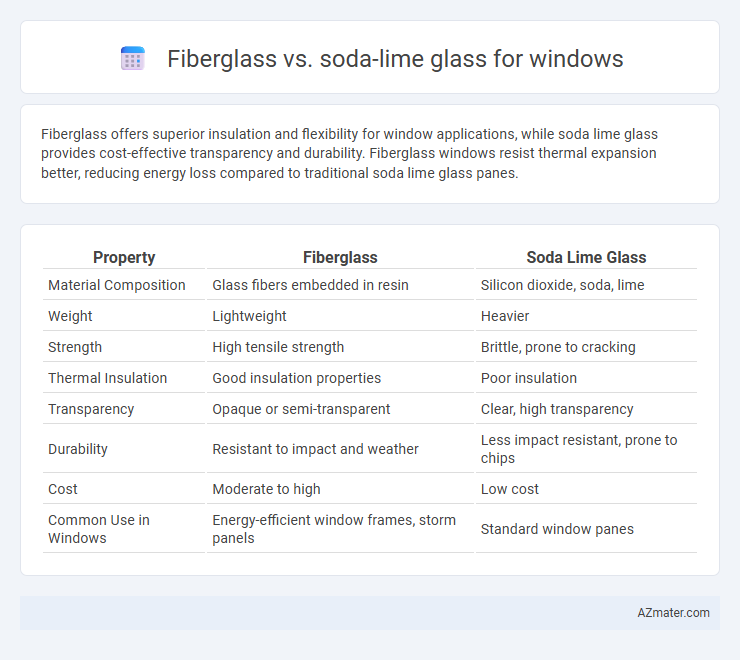Fiberglass offers superior insulation and flexibility for window applications, while soda lime glass provides cost-effective transparency and durability. Fiberglass windows resist thermal expansion better, reducing energy loss compared to traditional soda lime glass panes.
Table of Comparison
| Property | Fiberglass | Soda Lime Glass |
|---|---|---|
| Material Composition | Glass fibers embedded in resin | Silicon dioxide, soda, lime |
| Weight | Lightweight | Heavier |
| Strength | High tensile strength | Brittle, prone to cracking |
| Thermal Insulation | Good insulation properties | Poor insulation |
| Transparency | Opaque or semi-transparent | Clear, high transparency |
| Durability | Resistant to impact and weather | Less impact resistant, prone to chips |
| Cost | Moderate to high | Low cost |
| Common Use in Windows | Energy-efficient window frames, storm panels | Standard window panes |
Introduction to Glass Types for Windows
Fiberglass and soda lime glass are common materials used in window construction, each offering unique properties tailored for specific applications. Fiberglass windows provide superior thermal insulation, durability, and resistance to warping or rotting, making them ideal for energy-efficient and long-lasting installations. Soda lime glass, the most widely used glass type in windows, offers excellent clarity and affordability but requires additional treatments or lamination to enhance strength and thermal performance.
Overview of Fibre Glass Windows
Fiberglass windows offer superior durability and energy efficiency compared to soda lime glass windows, as they are made from reinforced plastic fibers that resist warping, cracking, and moisture damage. Fiberglass frames provide excellent thermal insulation, reducing heat transfer and improving indoor comfort while lowering energy costs. These windows also feature high strength-to-weight ratios, allowing for slimmer profiles and larger glass surfaces without compromising structural integrity.
Overview of Soda Lime Glass Windows
Soda lime glass, the most common type of glass used for windows, consists primarily of silica, soda ash, and lime, providing durability and cost-effectiveness. This glass offers excellent clarity and good thermal insulation, making it ideal for residential and commercial window applications. Compared to fiberglass, soda lime glass has higher rigidity and better scratch resistance, although it is more prone to breakage under impact.
Strength and Durability Comparison
Fiberglass offers superior tensile strength and resistance to impact compared to soda lime glass, making it highly durable for window applications in harsh environments. Soda lime glass, while cost-effective and widely used, is more prone to cracking and shattering under stress due to its brittle nature. Fiberglass windows also provide better thermal insulation and greater resistance to weathering, extending their lifespan significantly beyond traditional soda lime glass.
Thermal Insulation Properties
Fibre glass offers superior thermal insulation properties compared to soda lime glass, due to its low thermal conductivity and high resistance to heat transfer, making it an ideal choice for energy-efficient windows. Soda lime glass, commonly used in standard windows, has higher thermal conductivity, resulting in greater heat loss and less effective temperature regulation. Utilizing fibre glass in window frames and panels enhances overall insulation performance, reducing heating and cooling costs significantly.
Resistance to Weather and UV Exposure
Fiberglass windows offer superior resistance to weather and UV exposure compared to soda lime glass windows, as fiberglass frames do not warp, crack, or discolor under prolonged sun and moisture conditions. Soda lime glass, commonly used in traditional windows, can suffer from surface degradation and mineral buildup when exposed to harsh environmental elements over time. The enhanced durability of fiberglass makes it an ideal choice for maintaining clarity and structural integrity in diverse climates.
Cost and Affordability
Soda lime glass remains the most cost-effective option for window applications due to its widespread production and availability, significantly reducing initial investment compared to fiberglass. Fiberglass windows, while more expensive upfront, offer enhanced durability and energy efficiency, which can lead to long-term savings on maintenance and utility bills. For budget-conscious projects, soda lime glass provides affordability, whereas fiberglass appeals to those prioritizing performance and lifespan despite higher initial costs.
Maintenance and Longevity
Fibre glass windows offer superior durability and low maintenance compared to soda lime glass, resisting warping, cracking, and corrosion over time. Soda lime glass, commonly used in traditional windows, requires more frequent cleaning and is prone to scratches and breakage, reducing its longevity. Fibre glass frames also provide enhanced thermal insulation and UV resistance, extending the lifespan of the window system.
Environmental Impact and Sustainability
Fibre glass windows offer enhanced energy efficiency by providing superior insulation and reducing heating and cooling demands, lowering overall carbon emissions compared to soda lime glass. Soda lime glass, commonly used in windows, involves higher energy consumption in manufacturing and is less effective at thermal insulation, contributing to increased environmental impact. Fibre glass also has a longer lifespan and is recyclable, promoting sustainability through waste reduction and resource conservation.
Choosing the Right Glass for Your Windows
Soda lime glass, commonly used for windows, offers high clarity, durability, and cost-effectiveness, making it ideal for standard residential and commercial applications. Fiberglass glass, typically reinforced with fiberglass strands, enhances impact resistance and thermal insulation but often comes at a higher price point. Choosing the right glass involves balancing factors like energy efficiency, longevity, safety requirements, and budget constraints to determine the most suitable window glass material.

Infographic: Fibre glass vs Soda lime glass for Window
 azmater.com
azmater.com